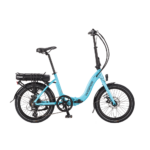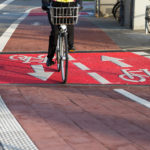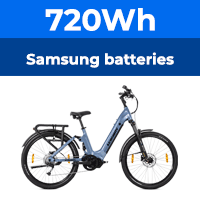Coming Soon .... Project Beastamatic
- Thread starter Fordulike
- Start date
Got all the bits and bobs for the project, and spent about an hour fitting it all to the bike.
It taught me a lesson or two about any future kit projects I may embark on.
The good news is that a 36v battery works very well with the original controller and hub motor set-up.
The bad news. Even though the seat post rack was specced to carry 9kg, the reality is that it bent after a few rides
The battery only weighs 5kg!!!
Some good news came out of this, as I will house the battery in the frame on any future projects.
Needless to say, I am now going to buy a rear rack that has the supporting legs to the rear fixings.
List of parts used:
The battery is a 36v 10Ah, aluminium cased Phylion, from an Alien Gents Special.
The rack, as mentioned, is a seat post type, not suitable for more than some sandwiches
The lead used to connect the battery to the controller, is a male to female IEC computer type lead, with the female end cut off.
4 x worm drive hose clips, large enough to fit around battery and rack to secure.
About half a metre of copper pipe foam insulation.
Some cable sized heat shrink.
The worm drive hose clips were used to attach the battery to the rack.
I inserted a piece of foam matting between rack and battery for a little bit of shock protection.

Here is the battery output socket and the lead that I used for connection to the controller.
You can just see where the rack started to buckle, near the seat post.

I ran the cable inside some copper pipe insulation, just to make it look a little neater, and to protect the cable.

Then I terminated the cable directly to the two prongs that stick up from the bottom bracket.
The prongs mate with the original battery when it is slid into place.
I had slipped a bit of heat shrink tubing on each of the power lead wires beforehand.
After they were soldered into place, I then ran a hair dryer over the heat shrink to protect the connections a little better.

I managed a couple of good runs on this set-up, before I noticed the failing rack problem.
Originally, I thought that the controller was chip controlled to regulate the maximum speed.
All I'm going to say is, that it doesn't limit the maximum speed.
As for the pulling power, this is what the Cyclamatic, sorry Beastamatic, should have been like all along.
I believe that the higher voltage helps the controller to run more efficiently and it feels like a completely different bike.
It taught me a lesson or two about any future kit projects I may embark on.
The good news is that a 36v battery works very well with the original controller and hub motor set-up.
The bad news. Even though the seat post rack was specced to carry 9kg, the reality is that it bent after a few rides
The battery only weighs 5kg!!!
Some good news came out of this, as I will house the battery in the frame on any future projects.
Needless to say, I am now going to buy a rear rack that has the supporting legs to the rear fixings.
List of parts used:
The battery is a 36v 10Ah, aluminium cased Phylion, from an Alien Gents Special.
The rack, as mentioned, is a seat post type, not suitable for more than some sandwiches
The lead used to connect the battery to the controller, is a male to female IEC computer type lead, with the female end cut off.
4 x worm drive hose clips, large enough to fit around battery and rack to secure.
About half a metre of copper pipe foam insulation.
Some cable sized heat shrink.
The worm drive hose clips were used to attach the battery to the rack.
I inserted a piece of foam matting between rack and battery for a little bit of shock protection.

Here is the battery output socket and the lead that I used for connection to the controller.
You can just see where the rack started to buckle, near the seat post.

I ran the cable inside some copper pipe insulation, just to make it look a little neater, and to protect the cable.

Then I terminated the cable directly to the two prongs that stick up from the bottom bracket.
The prongs mate with the original battery when it is slid into place.
I had slipped a bit of heat shrink tubing on each of the power lead wires beforehand.
After they were soldered into place, I then ran a hair dryer over the heat shrink to protect the connections a little better.

I managed a couple of good runs on this set-up, before I noticed the failing rack problem.
Originally, I thought that the controller was chip controlled to regulate the maximum speed.
All I'm going to say is, that it doesn't limit the maximum speed.
As for the pulling power, this is what the Cyclamatic, sorry Beastamatic, should have been like all along.
I believe that the higher voltage helps the controller to run more efficiently and it feels like a completely different bike.
Last edited:
Along with my previous controller mod, it certainly has added some pep to the original lacklustre performance.Sounds good, I'm glad the controller was happy with the voltage increase. The performance must be quite something compared with the original.
Just hope my new rack doesn't buckle like the first one
D
Deleted member 4366
Guest
I think your still short of a few volts. Look at the speed of this one. shame there's no picture of the actual bike.
Cyclamatic Power Plus with 48v ( Stock Hub 250w) commuting - YouTube
Cyclamatic Power Plus with 48v ( Stock Hub 250w) commuting - YouTube
Well theirs hasn't blown up with 48v, so there's hope for mine yetI think your still short of a few volts. Look at the speed of this one. shame there's no picture of the actual bike.
Cyclamatic Power Plus with 48v ( Stock Hub 250w) commuting - YouTube
Great pioneering work Fordulike!
Is the hill climbing better too with increase in voltage? Amps=torque, volts=speed I've gleaned as a simplistic rule of thumb so wondered if it made a difference to that aspect rather than just top speed? I understand that wattage increases too so I would have thought it likely to be better to a degree but not very efficient at lowish speeds.
I've done the shunt mod but notice only a little improvement with quite a lump of solder attached! (Maybe I'll redo it better). I'm determined to get up 6-7% hills off road with no pedaling! Next thing for aesthetics would be, if poss, to get a decent 36V batt that fitted the slim old batt case and a small enough new controller that allowed more amps. I bet the Bafang motor can take quite a few hundred watts without turning the gears to 'peanut butter' - but me slowly 'churning' up hills with no pedaling would be more likely to produce that heat....
Is the hill climbing better too with increase in voltage? Amps=torque, volts=speed I've gleaned as a simplistic rule of thumb so wondered if it made a difference to that aspect rather than just top speed? I understand that wattage increases too so I would have thought it likely to be better to a degree but not very efficient at lowish speeds.
I've done the shunt mod but notice only a little improvement with quite a lump of solder attached! (Maybe I'll redo it better). I'm determined to get up 6-7% hills off road with no pedaling! Next thing for aesthetics would be, if poss, to get a decent 36V batt that fitted the slim old batt case and a small enough new controller that allowed more amps. I bet the Bafang motor can take quite a few hundred watts without turning the gears to 'peanut butter' - but me slowly 'churning' up hills with no pedaling would be more likely to produce that heat....
It does feel quicker off the mark.Great pioneering work Fordulike!
Is the hill climbing better too with increase in voltage? Amps=torque, volts=speed I've gleaned as a simplistic rule of thumb so wondered if it made a difference to that aspect rather than just top speed? I understand that wattage increases too so I would have thought it likely to be better to a degree but not very efficient at lowish speeds.
I've done the shunt mod but notice only a little improvement with quite a lump of solder attached! (Maybe I'll redo it better). I'm determined to get up 6-7% hills off road with no pedaling! Next thing for aesthetics would be, if poss, to get a decent 36V batt that fitted the slim old batt case and a small enough new controller that allowed more amps. I bet the Bafang motor can take quite a few hundred watts without turning the gears to 'peanut butter' - but me slowly 'churning' up hills with no pedaling would be more likely to produce that heat....
I reckon it's down to better efficiency. Allowing the motor to get the power it wants, instead of choking it.
It just feels so much spritelier than the stock set-up.
Haven't fully tested it yet, as I am just waiting for the new rear rack to tip up.
I reckon this 36v battery from eBay would be a direct replacement for the stock 24v one.
Did toy with the idea of buying this a while back, but saving up for another project at mo.
Electric Bike Battery - 36V 9AH Lithium Ion | eBay
Will keep you updated
Couldn't wait for my new rack to arrive, so I carried out the following temporary mod, to get out on the bike again.

The end of the battery rests on the top bar, so no chance of it bending this time.
This also made me realize how much more balanced a bike is, when the battery is located centrally.
Picking up the bike and maneuvering it is so much easier
A battery located inside the frame triangle, would in my opinion be the best place to have it.... period.
The battery edges near the seat lightly brush the tops of my inner thighs, which didn't hinder peddling, but may have become irritating over a long distance.
I reckon if the stem attached to the rack was a little longer, then this could be a good place to mount the battery, as it would sit further along the top bar.
Someone asked if the hill climbing capabilities had improved.
Riding up and down a steep hill I have travelled countless times in 24v mode, 36v made a big difference.
On 24v with light peddling, the bike would make it to the top at an average of 7mph.
With the 36v battery, same light peddling, it went up at an average of 14mph.
It feels so mush more eager to assist on the hills. Although I wouldn't like to try on throttle alone for fear of overheating the controller or motor.
On slightly less steep hills, it powered along quite nicely on throttle alone.
Although I have a max speed figure along a nice stretch of flat ground, you will have to PM me if you want to know what it is.
I don't want to start off any more nasty debates

The end of the battery rests on the top bar, so no chance of it bending this time.
This also made me realize how much more balanced a bike is, when the battery is located centrally.
Picking up the bike and maneuvering it is so much easier
A battery located inside the frame triangle, would in my opinion be the best place to have it.... period.
The battery edges near the seat lightly brush the tops of my inner thighs, which didn't hinder peddling, but may have become irritating over a long distance.
I reckon if the stem attached to the rack was a little longer, then this could be a good place to mount the battery, as it would sit further along the top bar.
Someone asked if the hill climbing capabilities had improved.
Riding up and down a steep hill I have travelled countless times in 24v mode, 36v made a big difference.
On 24v with light peddling, the bike would make it to the top at an average of 7mph.
With the 36v battery, same light peddling, it went up at an average of 14mph.
It feels so mush more eager to assist on the hills. Although I wouldn't like to try on throttle alone for fear of overheating the controller or motor.
On slightly less steep hills, it powered along quite nicely on throttle alone.
Although I have a max speed figure along a nice stretch of flat ground, you will have to PM me if you want to know what it is.
I don't want to start off any more nasty debates
So what might burn out if using the throttle only on a hill now? My reading around has led to the 'a little knowledge is a dangerous thing' stage!
The shunt, modded or not, limits the current draw right? Presumably you're only drawing a poss max of 36VX20A=720W, less is likely. Flecc said when talking re 250W motors I believe,
18th April 2011 11:28 #8
flecc
'I agree with d8veh, and like him and member Tiberius I've measured the consumption on some Bafang motors. The continuous figure capability on the most powerful eZee controller setup with the Bafang is easily 750 watts and short term peaks of 1000 watts are evident. Tiberius (Nick) measured over 1000 watts.'
Hub motors
So shouldn't be too much draw. Maybe at slow speeds uphill a lot of watts would turn to heat?
I'm tempted to get a higher C rated 36V batt and try to get the controller drawing 20A or maybe buy one that will cope from BMSBattery. I either need a new bike or to get this Cyclamatic hauling me up hills. It's been a real joy to be able to get out into the countryside again using it though and I shall have fond memories just for that if I have to jettison it. So it's more power or bust! - or lose 4 stones....? - nah, more power.
The shunt, modded or not, limits the current draw right? Presumably you're only drawing a poss max of 36VX20A=720W, less is likely. Flecc said when talking re 250W motors I believe,
18th April 2011 11:28 #8
flecc
'I agree with d8veh, and like him and member Tiberius I've measured the consumption on some Bafang motors. The continuous figure capability on the most powerful eZee controller setup with the Bafang is easily 750 watts and short term peaks of 1000 watts are evident. Tiberius (Nick) measured over 1000 watts.'
Hub motors
So shouldn't be too much draw. Maybe at slow speeds uphill a lot of watts would turn to heat?
I'm tempted to get a higher C rated 36V batt and try to get the controller drawing 20A or maybe buy one that will cope from BMSBattery. I either need a new bike or to get this Cyclamatic hauling me up hills. It's been a real joy to be able to get out into the countryside again using it though and I shall have fond memories just for that if I have to jettison it. So it's more power or bust! - or lose 4 stones....? - nah, more power.
The only concern I have, is that the controller may get too hot on long uphill, throttle only runs.So what might burn out if using the throttle only on a hill now? My reading around has led to the 'a little knowledge is a dangerous thing' stage!
The shunt, modded or not, limits the current draw right? Presumably you're only drawing a poss max of 36VX20A=720W, less is likely. Flecc said when talking re 250W motors I believe,
18th April 2011 11:28 #8
flecc
'I agree with d8veh, and like him and member Tiberius I've measured the consumption on some Bafang motors. The continuous figure capability on the most powerful eZee controller setup with the Bafang is easily 750 watts and short term peaks of 1000 watts are evident. Tiberius (Nick) measured over 1000 watts.'
Hub motors
So shouldn't be too much draw. Maybe at slow speeds uphill a lot of watts would turn to heat?
I'm tempted to get a higher C rated 36V batt and try to get the controller drawing 20A or maybe buy one that will cope from BMSBattery. I either need a new bike or to get this Cyclamatic hauling me up hills. It's been a real joy to be able to get out into the countryside again using it though and I shall have fond memories just for that if I have to jettison it. So it's more power or bust! - or lose 4 stones....? - nah, more power.
This is because it is mounted inside a container on the bottom bracket, and heat dispersal may be an issue.
I'll be the guinea pig and do some long uphill runs with the throttle only.
Not too fussed if something blows.
Might get a long ride out tommorrow if my rack comes early
If you have enough torque to over come the hill then the high voltage will take you up faster. If the torque cant over come the hill then the voltage simply goes into heating the motor coils.
Backing off the throttle under this load reduces the effective voltage applied to the motor but places the controller under more stress....lots of explanation over on ES, essentially the controller is an efficient voltage to current converter and to maintain the climb up the hill with reduced motor voltage means more current applied to the motor phase coils. The controller has the ability to trade volts for amps and will increase the current in each phase to compensate. This places more stress on the FET's in the controller and increases losses slightly.
The shunt measures battery current but has no direct relation to the phase current the motor sees, The phase current is normally a best guess made by the controller based on a multiplication factor of the battery current. So the phase could be 2x higher than battery at some point. Also, as motor efficiency drops rapidly with lowering RPM under load more of the battery energy is turned into heat within the motor, so with increased voltage its best to rider faster up hills than previously to keep motor coil heating down. Typically half the unloaded motor top speed is best for this and climbing ability...
Backing off the throttle under this load reduces the effective voltage applied to the motor but places the controller under more stress....lots of explanation over on ES, essentially the controller is an efficient voltage to current converter and to maintain the climb up the hill with reduced motor voltage means more current applied to the motor phase coils. The controller has the ability to trade volts for amps and will increase the current in each phase to compensate. This places more stress on the FET's in the controller and increases losses slightly.
The shunt measures battery current but has no direct relation to the phase current the motor sees, The phase current is normally a best guess made by the controller based on a multiplication factor of the battery current. So the phase could be 2x higher than battery at some point. Also, as motor efficiency drops rapidly with lowering RPM under load more of the battery energy is turned into heat within the motor, so with increased voltage its best to rider faster up hills than previously to keep motor coil heating down. Typically half the unloaded motor top speed is best for this and climbing ability...
It's official... the Beastamatic is dead 
Got the battery all nicely fitted to the new rack, and took it out for a torture test.
It was throttle all the way, with light pedaling up steep hills to help the motor.
Six miles later, the throttle battery indicator lights went out.
No problem I thought, probably the battery run out of juice (it's old) or the fuse had blown in the battery.
Got back, checked fuse.. ok... charged battery back to 41v, still nothing.
My theory is the one that I thought might happen all along. The controller overheated and went bye bye.
Either that or the motor windings fried.
Anyway, I have tested the waters, the ride was amazing (while it lasted) and I have learnt lots and lots along the way.
I really haven't got the time to fault find and replace parts, so it's getting used as a normal bike at mo. Human powered
The Beastamatic may be be dead, but my next project will be much more robust, and something special.
Here are a few things I learnt, which may help in other forum member's decision making:
The best place for a battery anything over 5kg, is in the frame triangle.
A bike is way too rear heavy using big batteries on a rear rack. Plus ultimate handling may be an issue.
Although expensive, quality triangle frame A123 batteries can be purchased from this site:
Shop Online
The guy that sells them is Cellman over at Endless Sphere.
He's well established and respected, and the battery can be bought with a frame bag designed specially for it.
Lovely solution
The more amps you're drawing from the controller, the better ventilated it needs
to be to avoid overheating.
Seat post rear racks are not suitable for anything over a couple of kg's.
Always over engineer your bike setup. It'll save you cash in the long run.
Got the battery all nicely fitted to the new rack, and took it out for a torture test.
It was throttle all the way, with light pedaling up steep hills to help the motor.
Six miles later, the throttle battery indicator lights went out.
No problem I thought, probably the battery run out of juice (it's old) or the fuse had blown in the battery.
Got back, checked fuse.. ok... charged battery back to 41v, still nothing.
My theory is the one that I thought might happen all along. The controller overheated and went bye bye.
Either that or the motor windings fried.
Anyway, I have tested the waters, the ride was amazing (while it lasted) and I have learnt lots and lots along the way.
I really haven't got the time to fault find and replace parts, so it's getting used as a normal bike at mo. Human powered
The Beastamatic may be be dead, but my next project will be much more robust, and something special.
Here are a few things I learnt, which may help in other forum member's decision making:
The best place for a battery anything over 5kg, is in the frame triangle.
A bike is way too rear heavy using big batteries on a rear rack. Plus ultimate handling may be an issue.
Although expensive, quality triangle frame A123 batteries can be purchased from this site:
Shop Online
The guy that sells them is Cellman over at Endless Sphere.
He's well established and respected, and the battery can be bought with a frame bag designed specially for it.
Lovely solution
The more amps you're drawing from the controller, the better ventilated it needs
to be to avoid overheating.
Seat post rear racks are not suitable for anything over a couple of kg's.
Always over engineer your bike setup. It'll save you cash in the long run.
You could test for continuity through the motor windings using an ohm meter to see if the motor is fried. If it has burnt out on of the windings you will get an open circuit. I think it is more likely the controller has overheated and fried - could just be one of the transistors in it has died?
The problem was a bit weirdYou could test for continuity through the motor windings using an ohm meter to see if the motor is fried. If it has burnt out on of the windings you will get an open circuit. I think it is more likely the controller has overheated and fried - could just be one of the transistors in it has died?
After I got the bike home, checked the fuse and charged the battery, it did fire back into life again. Lights on throttle lit too.
Half way round the block, it died again. This time, the lights show on the throttle, but doesn't work on throttle or pedal sensor.
Power is going through the controller, so maybe you are right that the motor has fried.
Thanks for the offer NRG, but I'm going to concentrate on my next project.Interesting, at 36v I would have thought it to be OK. I can take a look at it if you want (pm me) but cant promise to get it going again....
I'm glad that I tinkered with the Cyclamatic beforehand.
Now I know exactly what I want from my next bike
Related Articles
-
 MTF Enterprises announces acquisition of EMU Electric Bikes
MTF Enterprises announces acquisition of EMU Electric Bikes- Started by: Pedelecs
-
 Wisper 806T folding bike wins Which? ‘Best Buy’
Wisper 806T folding bike wins Which? ‘Best Buy’- Started by: Pedelecs
-
 Sustrans calls for protected cycle lanes
Sustrans calls for protected cycle lanes- Started by: Pedelecs
-
 Amazon launch their first UK e-cargo micromobility hub
Amazon launch their first UK e-cargo micromobility hub- Started by: Pedelecs



